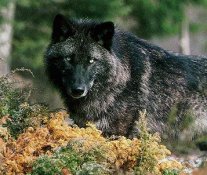|
|
|
Wolf, a truly a noble creature
 Wolves - very ritualistic animals - live by very carefully designed rules. Their sense of family is strong and loyal, with their social behavior based on a hierarchical structure. In other words, each has its place and function in the pack, or hierarchy.

These images show just a few examples of wolves communicating with one another. Body language involves the carriage set of the tail, hair (or hackels) raised to various levels and stance of the body, to name a few. Verbally, wolves emit many different growls, whines, barks and "huffs" of air. The pitch and length of their howl - unique to each wolf - also relays much information.
Although still cast as the blood-thirsty villian in folklore and children's stories, the public's image of wolves is finally improving, with interest in their preservation growing. Healthy wolves rarely ~ if ever ~ attack humans. The mortality factors affecting wolves include : persecution by humans; killing by other wolves; diseases; parasites; starvation and injuries by prey.
For those willing to listen, the wolf teaches us to know who we are, and to develop strength, confidence and surety in what we do ~ without ~ 'proving' ourselves, to others.

I wish to thank Monty Sloan
of Wolf Park, for the use of his beautiful photo's. Most of the photo's on these pages are owned and copyrighted by Mr. Sloan.
View Guestbook | Sign Guestbook |